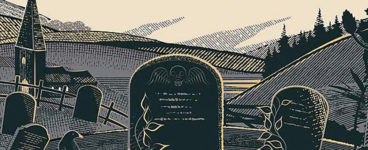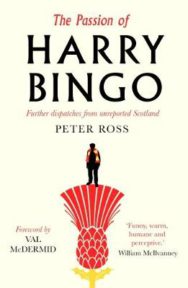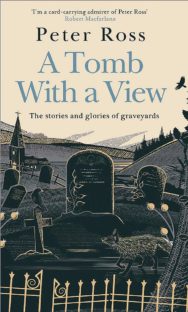David Robinson Reviews
‘In our culture, Death has made exactly the same transition, from central to fringe, visible to obscured.’
Peter Ross has been writing, with great empathy and care, of lives great and small throughout his journalistic career. David Robinson finds he brings the same skill and sensibilities to his new book on death and burial, A Tomb With a View.
A Tomb with a View: The Stories and Glories of Graveyards
By Peter Ross
Published by Headline
Whether with a ton of earth above us or an hour and a half at 900C in the incinerator, all our stories come to an end sometime. Opt for the former, though, and there is at least a sliver of hope of an afterlife. One day over the rainbow, Peter Ross might wander into your graveyard, notebook in hand.
It helps if you have had an interesting life or death. The first barmaid in England to have been eaten by a tiger (Hannah Twynoy, 23 October 1703, Malmesbury) makes it into his pages. So does the first woman to be bayoneted while fighting as a soldier in the British Army and then live until 108 (Phoebe Hessel, 12 December, 1821). But let’s face it, once you’ve stood in front of their lichened graves and read the inscriptions, unless you’re writing a biography, what else is there to say? Fascinating these lives may have been – and Ross is right, Hessel’s is a BBC drama series waiting to happen – but they have all reached a full stop. What can a writer add?
Quite a lot, as it happens, because there is always a lot more to say about death, especially in an age like ours which tries to block it out with an ocean of trivia. In 1859, when Jules Verne visited Edinburgh, he noted that, among the city’s haute bourgeoisie, one of the most popular destinations for a Sunday afternoon stroll was around the well-maintained paths and gardens of Warriston Cemetery. The Royal Botanic Garden had opened nearby just 40 years earlier, but to the promenading mid-Victorians, taking a gentle stroll around a garden of death was a comparable attraction. I know Warriston Cemetery reasonably well, and even though it is no longer the vandalised junkie playground it was in the Eighties, it is hidden away from the rest of the city, half overgrown, well off the tourist trail, and with nothing neat, tidy or haut bourgeois about it at all.
In our culture, Death has made exactly the same transition, from central to fringe, visible to obscured. These days, it’s the people who hang around graveyards, who openly talk about death, who are intrigued by our attitudes to it, who are the real oddities. Ross is one of them. Even as a child, growing up in Stirling, he haunted the nearby cemetery; in lockdown, he has found himself walking most days in the cemetery behind his house ‘as a vaccination against gloom’. And why not? It’s always consoling to find someone worse off than yourself, after all.
Taphophiles – people who are interested in cemeteries, funerals and gravestones – are an interesting bunch. What makes them go against the cultural current? What made Bob Reinhardt – who lives in the US – set up Friends of Warriston Cemetery and become so obsessed with the place that he has taken around 60,000 photos of it and other Edinburgh burial grounds? Why did John Constable (aka ‘urban magician’ John Crow) set up the Crossbones annual vigil for London’s medieval outcast dead outside the place where they were buried in unmarked graves? What made Nick Reynolds, Alabama 3’s harmonica player, start a new career as a death mask artist, taking casts from the freshly dead faces of the likes of Malcolm Maclaren and his own father, the Great Train Robber Bruce Reynolds?
In some ways, these people are the Thanatotic equivalents of the glorious eccentrics Ross has interviewed as a journalist. But he didn’t win all his many awards just for writing about colourful characters. He can also handle harder stories that blend history and culture too, sometimes ones you might never have thought of. What, for example, happens to urban graveyards when they are full up and no-one has any money to look after them? Should cemeteries with famous dead market themselves as tourist attractions? How do Muslims manage to bury their dead within 24 hours? Will we ever finish burying the dead of the First World War? (Answer: probably not). And are cillini – unmarked graves near churches for the unbaptised – doomed to be forgotten?
In his last book, The Passion of Harry Bingo, Ross wrote about how close journalistic observation is a form of compassion, and how while working on a story, all of his senses are engaged as he tries to understand, without any preconceived ideas, what is going on around him. Here, that seems particularly true of the chapters set in Dublin and – particularly – Belfast, where the ‘dark romance’ of the paramilitary dead colours the city ‘like some hidden pigment just outside the visible spectrum’.
Good feature writing demands having an eye for detail, an ability to ask tough questions and a certain humility too: the journalist is just a fly on the wall, not omniscient. Walking with the Easter Sunday parade to the Republican plot at Belfast’s Milltown Cemetery, Ross spots a little girl outside the Royal Belfast Hospital for Sick Children, banging gleefully on her dialysis machine as the marchers pass by, honouring the dead of the 1916 Easter Rising with flutes, drums and replica uniforms and rifles. He is accompanying former Sinn Fein spokesman Danny Morrison, who points out each place someone was killed by the British Army as they pass by. Could, he asks, the British soldiers who also died on these streets ever be commemorated too? Morrison’s answer takes him by surprise. The families of British soldiers know what to expect when their sons sign up, Morrison replies, so if they die on active service, that’s an end to it. ‘Well, that’s not the end of it for us,’ he adds. ‘Our dead are precious.’ Yet it’s surely blinkered to think that the other side’s dead aren’t precious too.
There’s a lot of history in these pages, as there has to be: the story of London’s ‘Magnificent Seven cemeteries’, from the ‘Victorian Valhalla’ of Kensal Green to Marx’s Highgate haven, demands it. But this is more than a book about the historical changes in the British and Irish way of death. Other writers could do that, and they’d all probably also finish by describing natural burial – sometimes called green or woodland burial. But I bet they wouldn’t end up, as Ross does, at one such natural cemetery overlooking the River Dart in Devon on a blustery All Souls’ Day. If they did, they probably wouldn’t find themselves talking to a woman whose husband had committed suicide while being mentally ill. And even if they did all that, I don’t imagine they would get to hear about how she broke off in the middle of putting the earth around his body with her bare hands to have a cigarette. How she took off his shroud just before he was put in the ground and how it now hangs above her fireplace. How they fell in love, and how it was a love story right to the end, even though in hindsight she realises he should have been sectioned.
Research gets you so far. But empathy gets you the whole story, the kind of story Ross heard from that woman in Devon and which is echoed throughout this engaging book, filled as it is with life, and loss, and love.
A Tomb With A View by Peter Ross is published by Headline, priced £20.
ALSO IN THIS ISSUE

 A Tomb With a View
A Tomb With a View
‘In our culture, Death has made exactly the same transition, from central to fringe, visible to obsc …

 The Garden Cure
The Garden Cure
‘I have seen over and over how people’s lives can be transformed – put back together and changed for …















